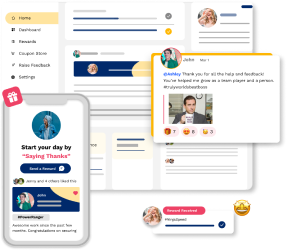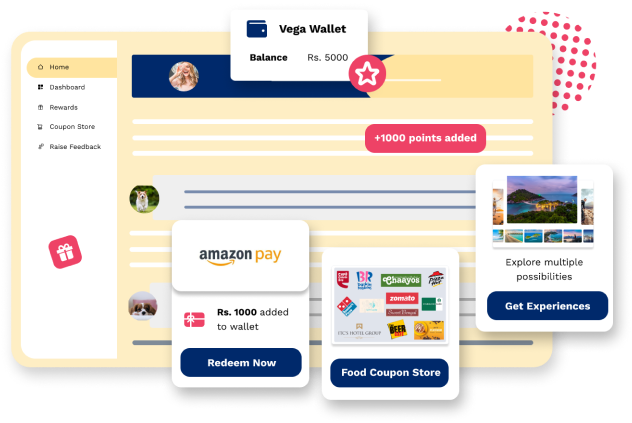Introduction
In today's corporate landscape, companies are increasingly struggling with a disengaged workforce, high attrition, low cultural alignment, and low productivity. Remote or hybrid work setups have become the norm, leading to employees feeling isolated and unheard of. Organizations generally resort to temporary fixes that may not address the core issue effectively. These quick fixes often include team lunches, sporadic cash bonuses, ad hoc rewards, and generic employee appreciation events. While these gestures can provide short-term boosts, they lack the sustainable impact of a comprehensive rewards and recognition program.
In fact, companies around the globe are spending upwards of 46 billion USD on employee rewards and recognition programs and have seen have 31% decrease in voluntary turnover and an 11.1% increase in average employee performance.
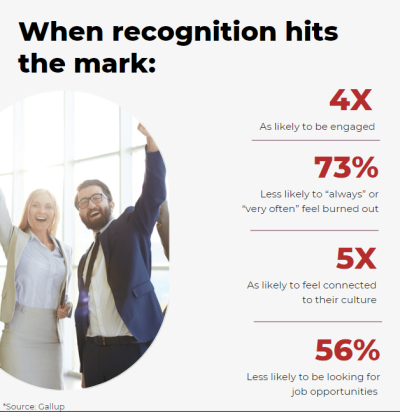
This clearly establishes the importance of how employee recognition plays a pivotal role in fostering a positive workplace culture and how having a rewards and recognition program ensures consistent and meaningful recognition and promotes ongoing employee engagement.
Why is Employee Recognition Important?
Think about it - when was the last time you were recognized for a job well done? How did it make you feel? Chances are, it made you feel valued, motivated, and eager to continue giving your best. The same holds true for employees in any organization.
Recognition goes beyond monetary rewards or flashy incentives. It's about recognizing employees' hard work, dedication, and achievements. It can take the form of a heartfelt thank-you, public praise, or even a simple handwritten note. The key is to make employees feel genuinely appreciated and recognized for their unique contributions. It has a profound impact on employee motivation, job satisfaction, productivity, and overall performance.
According to a survey by OC Tanner, 37% of respondents said that personal recognition is the most important driver of great work and would encourage them to do better work more often.
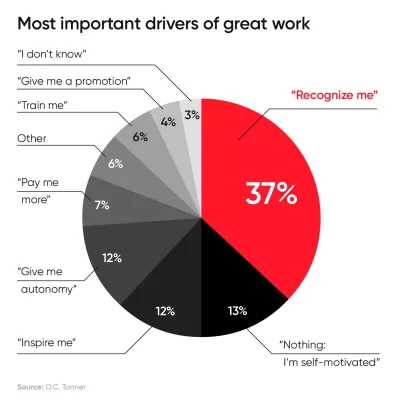
Here are some of the advantages of employee recognition Statistics:
- Builds a Positive Work Environment: According to Bureau of Labor Statistics, negativity can cost companies in the United States upwards of 3 billion USD annually. Recognition helps create a positive work culture where appreciation and acknowledgment are valued. When employees see their peers being recognized, it sets a positive tone and encourages a supportive and collaborative environment.
- Decreased Turnover and Improved Retention: As per research by Josh Bersin, organizations that scored in the top 20% for building a ‘recognition-rich culture’ had 31 percent lower voluntary turnover rates! Employee recognition plays a vital role in reducing turnover rates and retaining top talent. When employees feel valued and recognized, they are more likely to hang with the company, reducing recruitment and training costs.
- Increased Motivation and Engagement: According to Gallup, disengaged employees cost companies $450-$500 billion in lost productivity per year. Increasing a company’s engagement by just 10 percent can increase profits by $2,400 per employee per year. Recognition fuels employees' motivation, igniting their passion and commitment to their work. When the workforce feels valued and appreciated, they are more engaged in their tasks and eager to contribute their best efforts.
Keep Your Team Engaged and Motivated
- Send rewards and shortcuts
- Built a sense of purpose
- Hybrid-work friendly rewards
- Showcase your core values
Contact Us
- Drives Performance and Productivity: 69 percent of workers would work harder if they felt recognized at work, as per a survey by socialcast. Recognized employees tend to perform at higher levels. They are driven to excel and go the extra mile, resulting in increased productivity, improved quality of work, and better business outcomes.
- Attracting Top Talent: Organizations with robust employee recognition programs have a competitive edge in attracting top talent. Prospective employees seek out companies that prioritize employee appreciation, recognizing it as a sign of a positive and supportive work environment. According to a Randstad survey in Singapore, 41% of workers in the age group between 18-24 feel that they would rather be unemployed than feel unhappy in their jobs.
- Better Customer Experience: By recognizing employees, you enable them to cultivate positive relationships and prioritize exceptional customer service. Socialcast reports that companies with recognition programs have a 14% higher employee satisfaction rate and a 12% higher customer satisfaction rate. This, in turn, can have a crucial impact on revenue. Satisfied customers who experience outstanding service are more willing to pay premium prices and are more likely to refer others to your business, resulting in increased revenue and growth.
In today’s dynamic and competitive landscape where organizations are increasingly struggling with the disconnected workforce, it has become increasingly crucial for companies to understand the significance of recognition and its impact on various aspects of their business. To shed light on the subject, let's explore some compelling statistics that provide valuable insights into the positive outcomes that can be obtained by prioritizing employee recognition in your organization.
Statistics Related to Employee Retention:
- 32% of employees left their jobs because they were not satisfied with the recognition for their contributions. Source: LinkedIn
- Employees whose supervisors consistently acknowledge them for good work are 5x more likely to stay at the organization. Source: Qualtrics
- 73% of workers that are planning to leave said they would remain if offered more recognition. Source: Reward Gateway
- 63% of employees who feel recognized are unlikely to look for a new job. Source: Bonusly and SurveyMonkey.
- The primary reason, most employees leave their jobs is a lack of recognition - Source: Gallup
- For 55 percent of workers who planned to switch jobs, lack of recognition was the number one culprit in driving their decision. Source: Achievers
Statistics Related to Productivity and Performance:
- 69% of workers would work harder if they felt their efforts were better appreciated. Source: Aberdeen
- 88% of employees that receive strong performance recognition are proactively innovating. Source: Aedion
- 77.9% of workers would be more productive if they were recognized more frequently. Source: Nectar HR
- Employee productivity, performance, and engagement are 14% higher in organizations with recognition than in those without them. Source: Deloitte
- If corporations double the number of employees they recognize every week, there will be 24 percent improvement in quality of work. Source: Gallup
Statistics Related to Peer-to-Peer Recognition:
- Peer-to-peer recognition is 35.7% more likely to have a positive impact on financial results than supervisor-only recognition. Source SHRM
- Organizations using strategic peer recognition programs are 48% more likely to report high staff engagement. Source: People Pulse
- 41% of organizations that use peer-to-peer recognition have seen a positive increase in customer satisfaction. Source: Globoforce
- 65% of employees say peer recognition makes them feel more motivated to do their work at best terms. (Source: Forbes)
- 62% of employees say peer recognition makes them feel more connected to their team. (Source: Glassdoor)
Statistics Related to Recognition Programs:
- Companies with sophisticated employee recognition practices are on average 12x more likely to generate robust business outcomes than their peers. Source: Deloitte
- Employee recognition Statistics positively affect retention according to 68% of HR professionals. Source: SHRM
- Only 14% of organizations provide managers with the necessary tools for rewards and recognition. Source: Globoforce
- Organizations with effectual recognition programs have 31 percent lower voluntary turnover. Source: Bersin & Associates
- Well-designed R&R programs can drive an 11.1% increase in average employee performance. Source: Gartner
Statistics Related to Employee Engagement:
- According to 84% of HR professionals, employee recognition positively affects employee engagement. Source:
- 58% of employees say that their supervisors could engage them better by recognizing them. Source: Psychometrics
- Individuals who felt their employers’ rewards met their needs were 7x more likely to say they were engaged at the workplace than employees who were dissatisfied with their organizations’ rewards. Source: Alight.
- Employees that receive regular recognition are up to 8x more engaged. Source: Globoforce
- 72% of businesses agree that recognition impacts engagement positively. Source: Harvard Business Review
Statistics Relating Recognition with Company Values:
- Just 32% of HR leaders said their organization has a recognition program that involves a D&I component. Source: Dan Schawbel
- 52% of employees think that their recognition program is not aligned to organizational goals. Source: Deloitte
- 83% of HR leaders say employee recognition Statistics can strengthen organizational values. Source: Globoforce
- 88 percent of companies that tied employee recognition to core values said their programs aided, reinforce and instill those values, compared to 57% among companies that did not have that linkage. Source: SHRM
Statistics Related to Employees’ Preference in Recognition:
- 88% of millennials say that prepaid cards are their favorite type of monetary reward. Source: Blackhawk network
- 80% of Gen Y employees say they prefer on-the-spot recognition over formal reviews. Source: LinkedIn
- 54% of employees prefer verbal “Thank you” for their day-to-day accomplishments, while 47% of employees prefer growth opportunities for a significant accomplishment. Source: Deloitte
- 46% of employees appreciate small, unexpected rewards. Source: Zippia
- 57% of employees said they would choose the recognition in the form of cash or a bonus. Source: Survey Monkey
Statistics Related to Recognition from Managers and Leaders:
- Nearly 90% of workers who received recognition or thanks from their supervisors in the past month indicated higher trust levels in that supervisor. Source: Quantum Workplace
- 85% of workers believe that management should recognize a job well done whenever it occurs. Source: RewardGateway
- 50% of employees believe appreciation from managers improved their relationship with their higher-ups. Source: Cicero Group
- 24% of workers say that their most memorable recognition came from the CEO. Source: Gallup
- 52% of employees want more recognition from their immediate manager. Source: BambooHR
Employee Recognition Examples
By now you must have understood the importance of employee recognition Statistics and how it is the backbone that drives an organization’s success and growth. From simple gestures of appreciation to structured recognition programs, there are numerous ways to show employees that they are valued. In this section, we'll explore a range of examples of employee recognition that can be implemented to create a culture of appreciation within your organization:
Employee of the Month: Implementing an Employee of the Month program is a popular recognition practice. It recognizes outstanding employees for their exceptional performance, dedication, and contributions to the organization. This can include rewards such as a certificate, trophy, or special privileges like a small gift, a special parking spot, and much more.
Public Appreciation: Taking the time to express genuine gratitude and praise to employees can have a significant impact. Highlight their accomplishments and express gratitude for their hard work in front of their peers. For example, publicly acknowledging an employee's exceptional performance during a team meeting or sending a personalized email highlighting their achievements shows that their efforts are recognized and valued.
Performance Bonuses: Tie recognition to the performance by providing monetary rewards or bonuses for achieving specific goals or outstanding results. For example, offer a performance-based bonus to employees who consistently exceed their targets or contribute significantly to the company's success.
Professional Development Opportunities: Show employees that you value their growth and development by offering professional development opportunities. This can include sponsoring employees to attend industry conferences, providing access to online courses, or supporting them in pursuing certifications relevant to their roles. This recognition demonstrates a commitment to their long-term success.
Personalized Rewards: Tailor recognition to individual preferences and interests. For example, consider giving personalized rewards such as gift coupons to their favorite restaurants or stores, experiences like spa treatments or tickets to a concert, or customized tokens of appreciation based on their hobbies or interests.

Peer-to-Peer Recognition: Encourage employees to appreciate and recognize their colleagues' accomplishments. This can be done through a dedicated Slack/Teams channel where employees can publicly acknowledge and praise their peers' contributions. Another option is implementing a peer-nominated recognition program where employees can nominate their coworkers for exceptional work.
Surprise Celebrations: Organize surprise celebrations to recognize employees' achievements or milestones. It could be a surprise party, team lunch, or a small gathering where colleagues come together to celebrate an employee's success. For instance. For example, surprise an employee with a cake and balloons to celebrate their work anniversary or a major project accomplishment.
Appreciation Notes: Handwritten appreciation notes can have a personal touch that resonates with employees. Encourage managers and peers to write personalized notes expressing their appreciation for specific actions or behaviors. For example, leaving a thoughtful thank-you note on an employee's desk highlighting their exceptional customer service.
Wellness Initiatives: Show appreciation for employees' well-being by implementing wellness initiatives. This can include providing healthy snacks, offering gym memberships or fitness classes, organizing mindfulness sessions, or promoting work-life balance through initiatives like "Wellness Wednesdays" or "Digital Detox Days."

Employee Spotlight: Create an "Employee Spotlight" program where you feature an employee each week on your company's intranet, newsletter, or social media platforms. Share their achievements, contributions, and a short interview to showcase their talents and recognize their hard work. This not only celebrates the employee but also inspires others.
Flexible Work Arrangements: Show appreciation by offering flexible work arrangements, like remote work options, flexible hours, or compressed work weeks. This recognizes employees' need for work-life balance and promotes a positive work environment.
Celebrate Milestones: Celebrating professional and personal milestones at work is a significant way to foster a positive and supportive work environment. Recognizing and honoring significant achievements, both professional and personal, shows employees that their successes are valued and acknowledged. Health care system Texas Health Resources recognizes employees' milestone years of service at 5-year increments. At every milestone, honorees receive a beautiful customized celebratory yearbook. Each yearbook opens with a personalized congratulatory message of appreciation from the CEO. Inside, the honoree finds messages of thanks and appreciation from their manager and coworkers, as well as photos of the employee at work with their team, having fun and contributing to the mission.
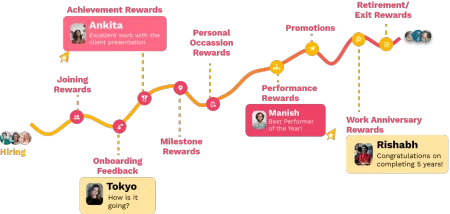
Creating a Successful Employee Recognition Program
A well-designed and effectively implemented employee recognition program has the potential to boost employee morale, increase engagement, and drive exceptional performance. However, creating a successful employee recognition program is not a one-size-fits-all endeavor. It requires careful planning, thoughtful execution, and a deep understanding of what motivates and inspires employees. Let’s discuss a few important things that you must keep in mind while designing your employee recognition program:
- Define Program Goals: Clearly outline the goals and objectives of your employee appreciation program. Determine what you want to achieve, whether it's boosting employee morale, increasing retention, or improving overall engagement.
- Gather Employee Feedback: Seek input from employees to understand their preferences and what types of recognition they find meaningful. Conduct surveys, focus groups, or one-on-one discussions to gather insights and tailor the program to their preferences.
- Establish Clear Criteria: Define the criteria for recognition, such as specific accomplishments, milestones, or behaviors that deserve appreciation. Organizations’ clear guidelines ensure consistency and fairness in recognizing employees' contributions.
- Provide Timely Recognition: Recognize employees promptly and be specific about what they are being appreciated for. This reinforces positive behavior and boosts morale. Instead of generic praise, highlight the specific actions or achievements that deserve recognition and tie them to organizational values.
- Encourage Peer-to-Peer Recognition: Foster a culture of peer-to-peer recognition by encouraging employees to appreciate and acknowledge each other's achievements. Implement platforms or systems that facilitate easy and visible peer recognition, such as a dedicated Teams channel or a wall of fame.
- Evaluate and Improve: Continuously assess the effectiveness of your employee appreciation program and gather feedback from both employees and managers. Monitor the impact on important metrics such as employee engagement level, job satisfaction, and retention rates. Use the feedback to make necessary adjustments and improvements to the program.
- Communicate and Reinforce: Regularly communicate the appreciation program to all employees. Ensure they understand how it works, the various recognition methods available, and the importance of participation. Reinforce the program's value through ongoing communication, reminders, and success stories via various channels, such as company-wide emails, team meetings, or internal newsletters.
By supporting the steps outlined above, companies can design a program that aligns with employee preferences, involves supervisors and peers, and provides timely and specific recognition. Regular communication, ongoing evaluation, and continuous improvement are key to sustaining the program's effectiveness. A well-designed employee appreciation program not only shows gratitude for employees' contributions but also strengthens their commitment, loyalty, and overall satisfaction.
Build a Culture of Recognition with Vega HR
Ensuring that recognition is ingrained throughout the organization is important. Recognition should be a core part of the overarching company culture. However, initiating a robust employee recognition program and gaining widespread participation can be challenging without the appropriate tools which is where Vega HR can help you bridge the gap.
To know how Vega HR can revolutionize your employee experience, book a free customized demo with us today.
About Vega HR
Vega-HR is a powerful tool in the talent war, offering employee rewards, recognition, and pulse recognition. With an engaging platform, it fosters a world-class work culture, providing P2P recognition, social feedback, on-spot recognition, and monetizable incentive solutions with 3000+ coupons in various categories.
Create a Culture People Want to Stick to
- Send rewards
- Give shoutouts
- Build a community
- Gift experiences
Get a demo
 Written by Nikhil Datta 02 June 2023 | 4 min read
Written by Nikhil Datta 02 June 2023 | 4 min read


